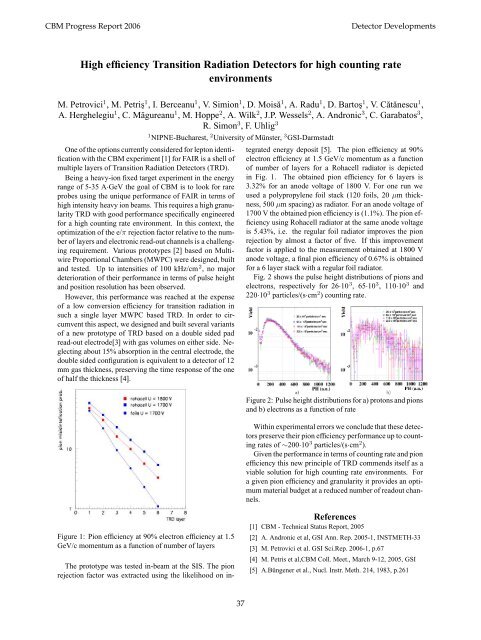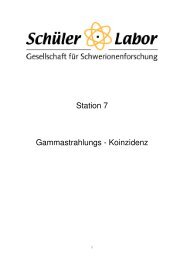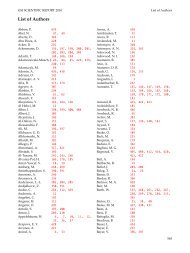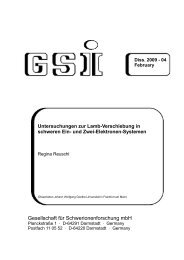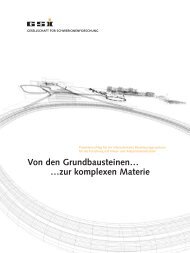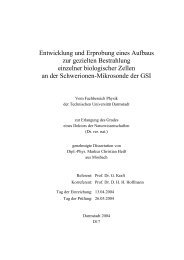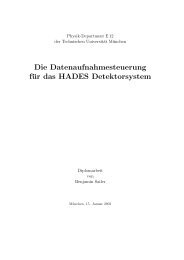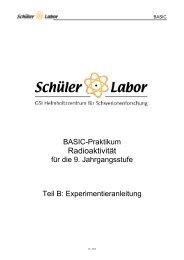CBM Progress Report 2006 - GSI
CBM Progress Report 2006 - GSI
CBM Progress Report 2006 - GSI
You also want an ePaper? Increase the reach of your titles
YUMPU automatically turns print PDFs into web optimized ePapers that Google loves.
<strong>CBM</strong> <strong>Progress</strong> <strong>Report</strong> <strong>2006</strong> Detector Developments<br />
High efficiency Transition Radiation Detectors for high counting rate<br />
environments<br />
M. Petrovici1 , M. Petris¸ 1 , I. Berceanu1 , V. Simion1 , D. Moisă1 , A. Radu1 , D. Bartos¸ 1 ,V.Cătănescu1 ,<br />
A. Herghelegiu1 ,C.Măgureanu1 , M. Hoppe2 ,A.Wilk2 , J.P. Wessels2 , A. Andronic3 , C. Garabatos3 ,<br />
R. Simon3 , F. Uhlig3 1 2 3 NIPNE-Bucharest, University of Münster, <strong>GSI</strong>-Darmstadt<br />
One of the options currently considered for lepton identification<br />
with the <strong>CBM</strong> experiment [1] for FAIR is a shell of<br />
multiple layers of Transition Radiation Detectors (TRD).<br />
Being a heavy-ion fixed target experiment in the energy<br />
range of 5-35 A·GeV the goal of <strong>CBM</strong> is to look for rare<br />
probes using the unique performance of FAIR in terms of<br />
high intensity heavy ion beams. This requires a high granularity<br />
TRD with good performance specifically engineered<br />
for a high counting rate environment. In this context, the<br />
optimization of the e/π rejection factor relative to the number<br />
of layers and electronic read-out channels is a challenging<br />
requirement. Various prototypes [2] based on Multiwire<br />
Proportional Chambers (MWPC) were designed, built<br />
and tested. Up to intensities of 100 kHz/cm 2 , no major<br />
deterioration of their performance in terms of pulse height<br />
and position resolution has been observed.<br />
However, this performance was reached at the expense<br />
of a low conversion efficiency for transition radiation in<br />
such a single layer MWPC based TRD. In order to circumvent<br />
this aspect, we designed and built several variants<br />
of a new prototype of TRD based on a double sided pad<br />
read-out electrode[3] with gas volumes on either side. Neglecting<br />
about 15% absorption in the central electrode, the<br />
double sided configuration is equivalent to a detector of 12<br />
mm gas thickness, preserving the time response of the one<br />
of half the thickness [4].<br />
Figure 1: Pion efficiency at 90% electron efficiency at 1.5<br />
GeV/c momentum as a function of number of layers<br />
The prototype was tested in-beam at the SIS. The pion<br />
rejection factor was extracted using the likelihood on in-<br />
37<br />
tegrated energy deposit [5]. The pion efficiency at 90%<br />
electron efficiency at 1.5 GeV/c momentum as a function<br />
of number of layers for a Rohacell radiator is depicted<br />
in Fig. 1. The obtained pion efficiency for 6 layers is<br />
3.32% for an anode voltage of 1800 V. For one run we<br />
used a polypropylene foil stack (120 foils, 20 µm thickness,<br />
500 µm spacing) as radiator. For an anode voltage of<br />
1700 V the obtained pion efficiency is (1.1%). The pion efficiency<br />
using Rohacell radiator at the same anode voltage<br />
is 5.43%, i.e. the regular foil radiator improves the pion<br />
rejection by almost a factor of five. If this improvement<br />
factor is applied to the measurement obtained at 1800 V<br />
anode voltage, a final pion efficiency of 0.67% is obtained<br />
for a 6 layer stack with a regular foil radiator.<br />
Fig. 2 shows the pulse height distributions of pions and<br />
electrons, respectively for 26·10 3 , 65·10 3 , 110·10 3 and<br />
220·10 3 particles/(s·cm 2 ) counting rate.<br />
Figure 2: Pulse height distributions for a) protons and pions<br />
and b) electrons as a function of rate<br />
Within experimental errors we conclude that these detectors<br />
preserve their pion efficiency performance up to counting<br />
rates of ∼200·10 3 particles/(s·cm 2 ).<br />
Given the performance in terms of counting rate and pion<br />
efficiency this new principle of TRD commends itself as a<br />
viable solution for high counting rate environments. For<br />
a given pion efficiency and granularity it provides an optimum<br />
material budget at a reduced number of readout channels.<br />
References<br />
[1] <strong>CBM</strong> - Technical Status <strong>Report</strong>, 2005<br />
[2] A. Andronic et al, <strong>GSI</strong> Ann. Rep. 2005-1, INSTMETH-33<br />
[3] M. Petrovici et al. <strong>GSI</strong> Sci.Rep. <strong>2006</strong>-1, p.67<br />
[4] M. Petris et al,<strong>CBM</strong> Coll. Meet., March 9-12, 2005, <strong>GSI</strong><br />
[5] A.Büngener et al., Nucl. Instr. Meth. 214, 1983, p.261


